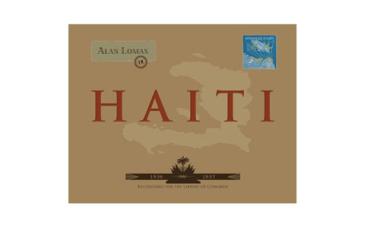When the first track of the sprawling 10-CD set Alan Lomax in Haiti hits your speakers, something unexpected happens: the music is instantly familiar. A clarinet carries the melody, and a great rhythm section undergirds it. There's something undeniably Caribbean about the vocals lilting along in Haitian French (Kreyol), but for the most part, it's easy to mistake the sounds for something wafting out of a New Orleanian dive circa 1930.
The notes explain that curious cross-pollination: U.S. Marines who occupied Haiti from 1915 to 1934 brought American jazz to the island of Hispaniola (which Haiti shares with the Dominican Republic), and Haitian musicians quickly incorporated the careening clarinet and swinging rhythms into their own merengue style.
Twenty-one-year-old Alan Lomax and his fiancee, Elizabeth Harold, visited Haiti in 1936, in a time of increased national identity in the wake of occupation. The equipment he brought was heavy and cumbersome, designed to cut grooves in metal discs, and the liner notes report that Lomax suffered from malaria. Nonetheless his perseverance netted him some 1,500 recordings and six films (the sort of effort which eventually secured his reputation as one of the most important ethnomusicologists of the 20th century). Somehow Lomax and Harold even found time to marry while they were there.
The recordings are a remarkable record of Haiti's past, and the music is like little else, a stew of French, African and American influences and a unique treasure, especially considering that the material remained unreleased for 70-plus years.
Alan Lomax's daughter Anna Lomax Wood explains in the notes how her father's recordings finally became available: "Examining the collection at the Library of Congress in the late 1990s, we were amazed to find over 50 hours of recorded music and film footage—some 1,500 items—and hundreds of pages of field notes and correspondence—70-year-old virgin material, in effect. … Two factors at last made it possible to consider publishing and disseminating the collection: a series of breakthroughs in audio technology made available to us sound restoration specialist Steve Rosenthal; and commitment to the project by a foremost authority on Haitian music, Gage Averill. Even so, the acoustic and editorial challenges were so formidable, and the costs so high, that it took another decade of archival digging, of painstaking musical, cultural and linguistic archeology and sound repair, performed in stages, to unveil this forgotten treasure."
Gage Averill's extensive liner notes, themselves the product of a gargantuan effort, include transcriptions and translations, and important info about what you're hearing. In summing up what Lomax was preserving, Averill says, "Lomax's activities chronicled a Haiti whose urban enclaves were modernizing but whose regions andeyo (outside the cities) were characterized by 18th-century agrarian practices with a culture heavily indebted to the legacy of sub-Saharan Africa."
The 10 discs include, among other things, work songs, celebration songs, worship songs, chants, children's music, French music and urban music. They offer a tremendously varied sampling of the sounds of a unique cultural outpost.
The sounds of voodoo (more properly vodou) are some of the most unusual in the set. They are often a nearly frantic call and response between a solo singer and a chorus of voices, underpinned by a repetitive tangle. That tangle is a combination of drums, rattles, scrapers and whistles accompanied by single-note bamboo trumpets played in looping patterns. The sounds are quite African, as are many of the gods of vodou. The music on this disc is called "rara," and is the sound of marching processions, a very public form of interacting with the gods of vodou.
Another stand-out disc in the set includes the music of a young woman named Francilia, a "ren chante," or queen of song. She shared with the Lomaxes some of her repertoire of ceremonial vodou music, and the effect is entirely different from that of rara. The sound is a bit out of context, according to the liner notes, because she sings without the customary chorus. These tunes are some of the most haunting material in the set—Francilia's voice is compelling, her singing clear and powerful with a wide range.
Though space does not permit a full rundown of 10 discs' worth of material, much of the pleasure of listening to its hours of music is the joy of discovery, of catching an unexpected thread of influence—say, a nearly European fiddle, or a decidedly African polyrhythm. It's likely that few listeners' ears will be used to the timbres and tones here, but that, of course, is precisely why this historical record is so valuable to experience.
In a time of upheaval for our neighbors to the south, Alan Lomax in Haiti also offers a rare and helpful glimpse into the history and culture of a long-troubled nation that's currently in crisis. The box set's price has just been reduced, and money from its purchase will go directly to relief efforts in the wake of the Haitian earthquake.
You can purchase the set at the reduced price, learn about Lomax and his trip, and check out music samples at http://thehaitibox.blogspot.com/.



